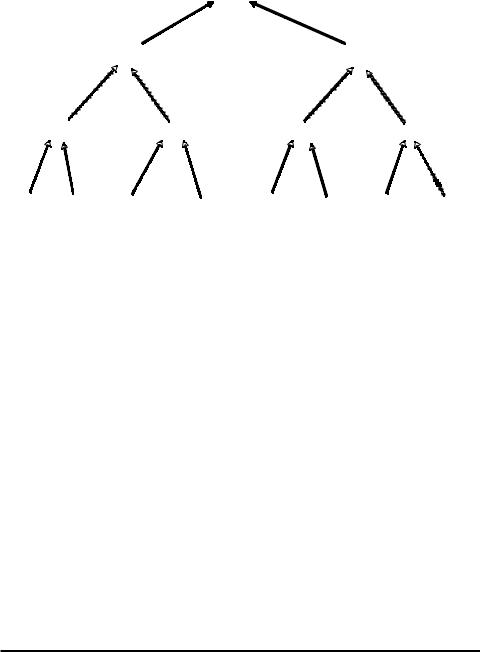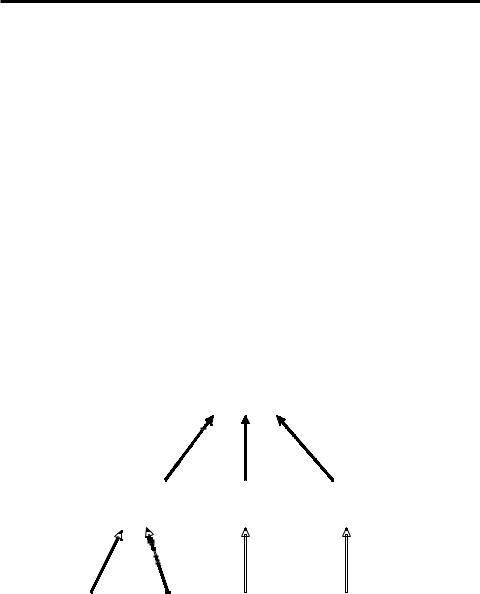
Narayanan V.K., Armstrong D.J. - Causal Mapping for Research in Information Technology (2005)(en)
.pdf360 Otondo
Traversal is often accomplished via iterative functions that typically use a relatively simple algorithm to step repetitively across node-arc-node segments. Iterative traversal functions can discover long chains of node-arc-node segments—something that is virtually impossible for causal beliefs represented in set-theoretic relational databases. However, care must be taken in the analysis of cyclic paths to avoid infinite loops. Therefore, more sophisticated algorithms—such as those that identify the existence of cyclic paths, or the shortest available path (e.g., Dijkstra, 1959)—should be applied.
Traversing a collection of causal maps can help a user identify characteristics of concatenated causal relationships between important organizational variables. For example, locating and resolving equivocalities—the existence of contradictory beliefs— is an important form of organizational learning (Weick, 1979). Equivocalities may exist in a number of forms. The simplest involves a direct contradiction between two causal
beliefs (e.g., x + → y, x −→ y). Another more complex example involves contradic-
tory paths of concatenated causal beliefs (e.g., x + → u + → y, x + → v −→ y). A third example can use categorical maps to locate equivocalities: the causal beliefs x + → y and x −→ z are equivocal if there exists a categorical relation between y and z such that y = z.
Methods that encode traversal algorithms offer a means for integrating causal knowledge (represented by causal maps) with multiple vocabularies, patterns of word use, assumptions, decision models, and other aspects of reasoning represented by categorical, associative, and other cognitive maps. This integration of multiple types of representations thus increases the depth of knowledge and semantic richness of a social causal mapping system. This increased depth of knowledge may also allow users to compare their causal beliefs to information contained in other organizational knowledge repositories. The usefulness of this last approach can be demonstrated in the following comparison of individual beliefs and empirical reports. Suppose that a particular belief
x + → y is held by a wide number of organization members. Suppose also that the
opposing belief x −→ y is not held by any organization member, but that an empirical report generated from the organization’s data mining programs supports the interpretation x −→ y. The contradictory interpretation x −→ y embodied within the empiri-
cal report is an example of causal associations generated from non-human, organizational memory.
The creation of these molecular organizational knowledge structures composed of humanand computer-generated components does not guarantee organizational learning will occur. However, it can help support organizational learning in at least two ways. First, it supplies useful raw materials for organizational learning processes, such as conflicting causal beliefs (i.e., equivocalities), undesirable feedback loops (e.g. “vicious circles”), and unintended effects (e.g., a change in one node may lead to an unwanted change in another). Second, it identifies individuals who can participate in social processes in which they may elaborate upon the richer context of that knowledge. That is, individuals who have contributed to the causal mapping system can be called upon at a later date to explain or elaborate their causal assertions.
Copyright © 2005, Idea Group Inc. Copying or distributing in print or electronic forms without written permission of Idea Group Inc. is prohibited.

Object-Oriented Approaches to Causal Mapping 361
Class Structures for Social Causal Mapping
Class structures describe the structure of the objects representing concepts, abstractions, and other items within a problem space. In other words, class structures provide blueprints for building the data structures and scripting the behaviors of objects within an object-oriented system. Class structures in the cognitive mapping domain would describe a variety of objects spanning a range of granularity. Class structures describing “fine-grained” objects serving as fundamental building blocks of a social causal mapping system would represent an individual’s concepts and assertions of causality (i.e., nodes and arcs, respectively). Those fundamental class structures must also describe methods to create, store, link, dispose of, and otherwise process nodes and arcs. Higher-level class structures would describe the building of “coarse-grained” objects from “finegrained” fundamental objects (e.g., aggregating nodes and arcs into causal maps). Methods associated with these higher-order objects would prescribe processes for analyzing large numbers of maps, such as identifying equivocalities and feedback loops within and between individual causal maps.
A thoughtful, coherent set of class structures can facilitate efficient software design and coding in many ways. Perhaps the most useful way to do so is by designing the class structures so that they integrate and cooperate with each other. This can be achieved in object-oriented design through hierarchies of interrelated classes in which commonlyused data and method structures are encoded in high-order “super-classes” that allow related lower-order “sub-classes” to re-use, or inherit, those structures. This and other applications of hierarchical classes structures will now be explored in the context of social causal mapping.
Hierarchies of Classes in Object-Oriented Design
Class hierarchies are based on what’s commonly called an “is-a” relationship. Objects exhibit an “is-a” relationship with their classes, just as someone’s pet dog “is-a” member of the canine family. Likewise, two classes can also be linked through an “is-a” relationship, just as a canine “is-a” type of mammal and a mammal “is-a” type of animal. “Is-a” relationships are transitive, so it can be said that a particular dog “is-an” animal.
Hierarchies of sub-classes and super-classes facilitate the creation and encoding of object-oriented software by allowing designers to conceptualize the given problem space at various levels of abstraction. This approach is similar to—but not exactly like— the common example of the taxonomies of animal species. For example, the generalized notion of “mammal” arises from the abstraction of common characteristics of groups such as lions, dogs, weasels, and humans: all are mobile, have seven vertebrae in their necks, nurse their young, and have hair. In turn, the term “animal” is a more abstract concept encompassing fish, birds, reptiles, mammals, and other mobile life forms. The abstract notions of “mammal” and “animal” are useful because they help biologists construct taxonomies that succinctly structure knowledge about related forms of life. A diagram
Copyright © 2005, Idea Group Inc. Copying or distributing in print or electronic forms without written permission of Idea Group Inc. is prohibited.

362 Otondo
Figure 3. Hierarchies of super-classes and sub-classes in the animal kingdom
Animals
Mammals |
Birds |
||||||
|
|
|
|
|
|
|
|
Carnivores |
Cetaceans |
Waterfowl |
Raptors |
||||||||||||
|
|
|
|
|
|
|
|
|
|
|
|
|
|
|
|
Dogs |
Cats |
Dolphins |
Fin whales |
Ducks |
Geese |
Hawks |
Eagles |
depicting a hierarchical, taxonomic structure of animal classifications is displayed in Figure 3.
Object-oriented design extends the notion of taxonomy beyond the hierarchical positioning of related groups and objects into an efficient approach to designing information systems. This approach relies upon inheritance, in which the characteristics of higherlevel classes are imparted to—or inherited by—their lower-level counterparts. Inheritance is particularly helpful in object-oriented design. It promotes the re-use of design structures, thus enhancing efficient program coding and consistency of design across the software and information system. It also helps ensure that important general structures and methods are not forgotten in the implementation of specialized subclasses.
Inheritance typically takes two steps. The first step involves grouping data structures and methods that are common to a set of classes within one class (e.g., the super-class CognitiveMap). Data structures and methods that are particular to one or more but not all members of that group are relegated to unique sub-class structures (e.g., the subclasses CausalMap, CategoricalMap, and AssociativeMap). The second step involves identifying the relationships between a super-class and its sub-classes. This step is typically accomplished with a software statement. The Java clause “class CausalMap extends CognitiveMap” is an example of how a super-class/sub-class relationship could be identified by a software statement.
Hierarchies of Classes for Social Causal Mapping
The similarities among the data structures and methods among causal, categorical, and other cognitive maps suggest that these classes can be arranged in one or more
Copyright © 2005, Idea Group Inc. Copying or distributing in print or electronic forms without written permission of Idea Group Inc. is prohibited.

Object-Oriented Approaches to Causal Mapping 363
hierarchies of sub-classes and super-classes. Three hierarchies are of immediate interest: one concerns the maps themselves (i.e., a hierarchy of cognitive maps), while two concern their constituent components (i.e., nodes and arcs).
A Hierarchy of Cognitive Maps for Social Causal Mapping
The general notion of cognitive maps can be abstracted from causal, categorical, and other similar types of representations. All are directed graphs composed of nodes and arcs, and all exhibit functionalities (i.e., encoded in their methods) that can contribute to the five OMIS functions conceptualized in Stein and Zwass (1995). It is these elements and characteristics that are common to and drawn from causal, categorical, and other related maps that are used to construct the super-class of cognitive maps (i.e., Class CognitiveMap). A diagram of these hierarchical relationships is displayed in Figure 4.
Cognitive map sub-classes (e.g., CausalMap, CategoricalMap) would inherit data and method structures delineated in Class CognitiveMap, but would also contain unique characteristics as well. For example, the Class CausalMap would contain a method to sum the “+” and “-” values in a chain of causal node-arc-node segments. Class CategoricalMap would not need that function because categorical arcs do not exhibit “+ or “-” values. Indeed, the differing natures of the nodes and arcs within the causal and categorical maps suggest that separate class hierarchies are needed for nodes and arcs. These two hierarchies are explored next.
Figure 4. Hierarchies of super-classes and sub-classes for social causal mapping
Cognitive Maps
|
Causal |
Categorical |
Associative |
||||||||||||||
|
|
Maps |
|
Maps |
Maps |
||||||||||||
|
|
|
|
|
|
|
|
|
|
|
|
|
|
|
|
|
|
|
|
|
|
|
|
|
|
|
|
|
|
|
|
|
|
|
|
|
|
|
|
|
|
|
|
|
|
|
|
|
|
|
|
|
|
|
|
|
|
|
|
|
|
|
|
|
|
|
|
|
|
|
|
Political |
Workflow |
Synonymous |
Content |
Maps |
Diagrams |
Terms |
Analysis |
Copyright © 2005, Idea Group Inc. Copying or distributing in print or electronic forms without written permission of Idea Group Inc. is prohibited.

364 Otondo
Hierarchies of Node and Arc Classes for Building Cognitive Maps
Hierarchies of superand sub-classes for nodes and arcs are based on several observations about their use in cognitive mapping. One observation is that object data structures and methods of nodes tend to be quite similar in cognitive maps, but those of arcs typically differ in important ways from each other. These differences require that class structures representing the various arcs must differ accordingly. For example, the arcs used in causal maps require a value to signify whether the relationship between the head and tail nodes is directly or inversely proportional (e.g., “+” and “-”). Arcs used in categorical maps represent similarities in linguistic meaning, so no variable exhibiting “+” or “-” values is required. These differences between causal and categorical arcs require differences in their data structures and methods. Class CausalArc would require a data element for the proportionality variable and a constructor method incorporating a proportionality variable as input. Class CategoricalArc would not have these requirements.
As with cognitive maps, the use of a super-class would offer the advantages of abstraction: common data elements (e.g., variables referencing the nodes at the ends of the arc) and methods would be embedded in a super-class (e.g., Class Arc). In turn, Classes CausalArc and CategoricalArc would inherit those common characteristics.
Conclusion
Causal maps are useful but limited representations of human causal reasoning. Those limitations constrain the usefulness of collections of causal maps in understanding and promoting social causal cognition. The chapter addresses those limitations in several ways.
First, an approach based on supplementing causal maps with other types of cognitive maps was described. These cognitive maps represent many of the processes in social causal reasoning that are not represented by causal maps, such as overcoming nuances of human language and thought, surfacing and challenging the participants’ assumptions, and documenting evidence from internal and external information repositories that supports or contradicts causal assertions. Simply linking individual causal maps together does not adequately represent these processes or their effects. Collections of causal, associative, categorical, and other types of cognitive maps can better represent the social processes of social causal reasoning than can causal maps alone.
The second lesson is that the information system representing the complex problem space of social causal mapping must itself be sufficiently complex. A logical model for a graph-theoretic, object-oriented social causal mapping system that is compatible with the directed graph structure of causal maps was presented. Class models were described that facilitate the incorporation of multiple, distributed types of organizational knowl-
Copyright © 2005, Idea Group Inc. Copying or distributing in print or electronic forms without written permission of Idea Group Inc. is prohibited.

Object-Oriented Approaches to Causal Mapping 365
edge maps into complementary, coherent representations. The use of classes and encapsulated iterative traversal functions were shown to provide more complete, more complex, derivable representations of knowledge at the organizational level. These enriched representations can assist in identifying interesting patterns of variables and relationships within the organization. These traversals were shown to assist in the inventorying of organizational knowledge, as well as assist in addressing such traditional organizational learning issues as equivocality reduction. These traversals can be recorded, permitting the construction of molecular components for organizational knowledge structure representation. Traditional relational databases that rely upon set theory are not sufficiently powerful to represent social causal mapping (e.g., multiple node-arc-node traversals).
The proposed social causal mapping system can be used to support an organization’s learning and knowledge management capabilities by facilitating the efficient and effective representation, construction, and integration of molecular components of organizational knowledge for the identification of interesting organization-level knowledge structures. These knowledge structures can then be used to identify contributing individuals and records that can provide the “fluid mix of framed experience, values, contextual information, and expert insight that provides a framework for evaluating and incorporating new experiences and information” (Davenport & Prusak, 1998). The proposed system may have other uses as well. For example, it could be used as a human resources tool to measure the extent to which employees contribute to learning and knowledge across the organization. This objective could be achieved by monitoring who contributes to the social causal mapping system, how often those contributions are used by others, and to what extent the contributions play a part in strategic, tactical, or operational improvements, product or service innovations, or increased organizational competitiveness.
Future work is needed before the proposed approach can be fully implemented. Classes of heuristics for the identification and manipulation of interesting components of organizational memory remain to be identified. Suitable applications of graph-theoretic algorithms remain to be tested. Object and class models for organizational knowledge structure representation must still be implemented.
References
Axelrod, R. (1976). Structure of decision: The cognitive maps of political elites. Princeton, NJ: Princeton University Press.
Boland, R. J., Tenkasi, R.V., & Te’eni, D. (1994). Designing information technology to support distributed cognition. Organization Science, 5, 456-475.
Booch, G. (1994). Object-oriented analysis and design with applications. 2nd edition. Reading, MA: Addison-Wesley.
Bougon, M. G. (1992). Congregate cognitive maps: A unified dynamic theory of organization and strategy. Journal of Management Studies, 29, 369-389.
Copyright © 2005, Idea Group Inc. Copying or distributing in print or electronic forms without written permission of Idea Group Inc. is prohibited.
366 Otondo
Codd, E. F. (1970). A relational model of data for large shared data banks. Communications of the ACM, 13, 377-387.
Davenport, T. H., & Prusak, L. (1998). Working knowledge: How organizations manage what they know. Boston: Harvard Business School Press.
Dijkstra, E. W. (1959). A note on two problems in connexion with graphs. Numerische Mathematik, 1, 269-271.
Eden, C. S., Ackermann, F., & Cropper, C. (1992). The analysis of cause maps. Journal of Management Studies, 29, 309-324.
Fiol, C. M., & Huff, A.S. (1992). Maps for managers. Journal of Management Studies, 29, 267-285.
Forrester, J. W. (1961). Industrial dynamics. Cambridge, MA: MIT Press.
Huber, G. P. (1991). Organizational learning: The contributing processes and the literatures. Organization Science, 2, 88-115.
Huff, A. S. (1990). Mapping strategic thought. In A. S. Huff (Ed.), Mapping strategic thought (pp. 11-49). Chichester: John Wiley & Sons.
Langfield-Smith, K. (1992). Exploring the need for a shared cognitive map. Journal of Management Studies, 29, 349-368.
Laukkanen, M. (1994). Comparative cause mapping of organizational cognitions. Organization Science, 5, 322-343.
Lyles, M.A. (1985). Organizational learning. Academy of Management Review, 10, 803813.
Montazemi, A. R., and Conrath, D. W. (1986). The use of cognitive mapping for information requirements. Management Information Systems Quarterly, 19(1), 4457.
Morecroft, J. D. W. (1988). System dynamics and microworlds for policymakers. European Journal of Operational Research, 35, 301-320.
Narayanan, V. K., & Fahey, L. (1990). Evolution of revealed causal maps during decline: A case study of Admiral. In A. S. Huff (Ed.), Mapping strategic thought (pp.109134). Chichester: John Wiley & Sons.
Nelson, K. M., Nadkarni, S., Narayanan, V. K., and Ghods, M. (2000). Understanding software operations support expertise: A causal mapping approach. Management Information Systems Quarterly, 24, 475-507.
Senge, P. M. (1990). The fifth discipline. New York: Doubleday.
Shaw, M. (1984, October). Abstraction techniques in modern programming languages.
IEEE Software, 10-26.
Smith, D.C.P. (1977b). Database abstractions: Aggregation and generalization. ACM Transactions on Database Systems, 2, 105-133.
Smith, J. M., & Smith, D.C.P. (1977a). Database abstractions: Aggregation. Communications of the ACM, 20, 405-413.
Stein, E. W., & Zwass, V. (1995). Actualizing organizational memory with information systems. Information Systems Research, 6, 85-117.
Copyright © 2005, Idea Group Inc. Copying or distributing in print or electronic forms without written permission of Idea Group Inc. is prohibited.

Object-Oriented Approaches to Causal Mapping 367
Sterman, J.D. (1992). Systems thinking and organizational learning: Acting locally and thinking globally in the organization of the future. European Journal of Operational Research, 59, 137-150.
Ullman, J. D. (1988). Principles of database and knowledge-base systems. Rockville, MD: Computer Science Press.
Weick, K. E. (1979). The social psychology of organizing, 2nd edition. Reading, MA: Addison-Wesley.
Winston, P. H. (1984). Artificial intelligence. Reading, MA: Addison-Wesley.
Endnotes
1The details of this storage design are beyond the scope of the present chapter, and are left for future work.
Copyright © 2005, Idea Group Inc. Copying or distributing in print or electronic forms without written permission of Idea Group Inc. is prohibited.

368 Narayanan and Liao
Chapter XV
An Outline of
Approaches to
Analyzing the Behavior
of Causal Maps1
V.K. Narayanan
Drexel University, USA
Jiali Liao
Drexel University, USA
Abstract
Analysis of the behavior of casual maps is not as well developed as the analysis of their content and structure. In this chapter, we propose a set of approaches to examine the behavior of causal maps. Simulation approaches that invoke computer simulations, influence diagrams and fuzzy causal maps are eminently suitable to examine the intrinsic behavior of causal maps. Empirical approaches attempt to build a theory of cognition-behavior linkages from the ground up, by unearthing stable linkages between cognition and behavior. Both approaches could be combined in major programs of research.
Copyright © 2005, Idea Group Inc. Copying or distributing in print or electronic forms without written permission of Idea Group Inc. is prohibited.

An Outline of Approaches to Analyzing the Behavior of Causal Maps 369
Introduction
In empirical works employing causal maps, researchers usually address the content, structure or behavior of causal maps (a point that was elaborated in Chapter I). Contentbased studies typically focus on the specific concepts in a causal map or the differences among concepts across maps. Structure refers to the pattern of relationships, or the differences among patterns in comparative studies. Indeed most of the studies reported in this book have chosen to focus on content or structure.
By the term, “the behavior of causal maps” we mean the prediction or analysis of decisions or actions that one can make, based on a given causal map. Some examples will illustrate the meaning of this definition. For example, if a firm constructed a competitor’s causal map with industry conditions as a set of causes and strategic actions as consequences, the firm may be interested in using the causal map to predict the behavior of its competitor, i.e., predicting its competitor’s strategic actions. This is of great interest in competitive intelligence systems. In another sense, behavior could refer to the analysis of the consequences of specific policy actions initiated by a firm. As an example, in Information System (IS) design work, if a causal map of the implementation process is constructed (that embraces relevant stakeholders), then designers can assess the consequences of various managerial alternatives in order to identify satisfactory actions that can be initiated by the management during implementation.
The analysis of the behavior of causal maps remains the Holy Grail in research using causal mapping. Although the analysis of behavior is much more prevalent in intervention contexts, empirical research on the behavior of causal maps is almost non-existent. This has been partly due to the absence of easily accessible methodological tools and theoretical lenses. Thus, the primary goal of this chapter is to invite future research in causal map theory focusing on behavior, not merely the content and structure of the maps. Specifically, the chapter aims to: 1) review and summarize promising avenues to connect causal maps and behavior; and 2) enumerate some specific tools to deploy in each avenue.
The scheme of this chapter is as follows: In the next section, we will provide an overview of the fruitful approaches to examining the behavior of causal maps. Following that, we will deal with three simulation approaches. Next we will sketch the empirical approach that we are beginning to witness in some disciplines. We will conclude with a comparative analysis of these approaches.
At the outset, we want to make one observation to place our discussion in perspective: Our approach is to identify fruitful, but not yet tested techniques for the analysis of the behavior of causal maps. Only as these techniques are put to use, will we know their relative merits or applicability. Thus, this chapter represents a preliminary guide to the uncharted territories that remain in the methodology of causal mapping.
Copyright © 2005, Idea Group Inc. Copying or distributing in print or electronic forms without written permission of Idea Group Inc. is prohibited.
